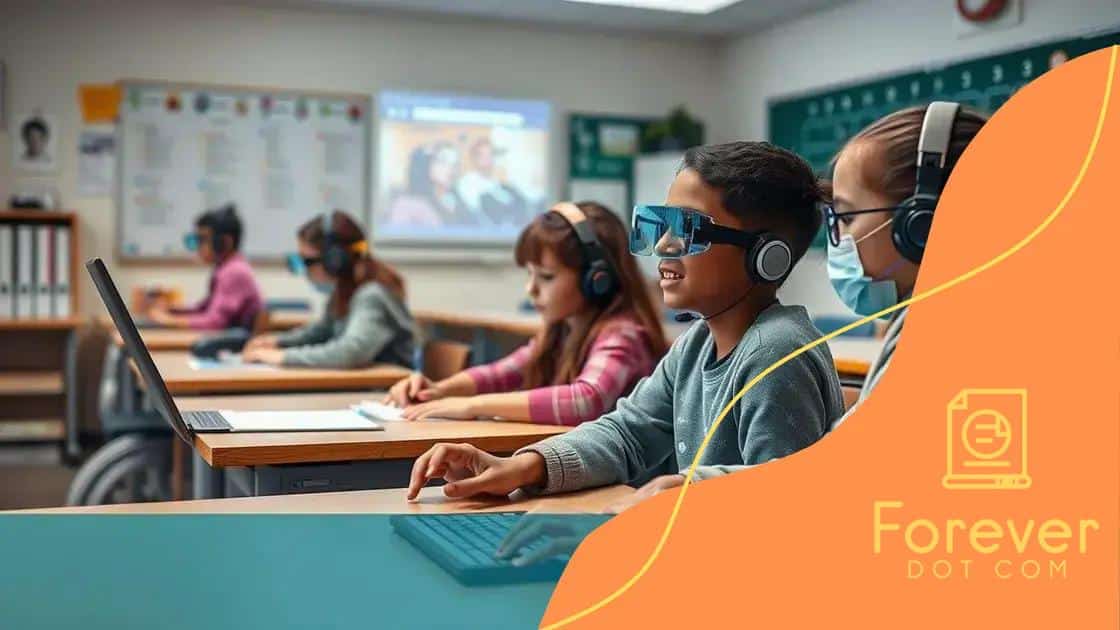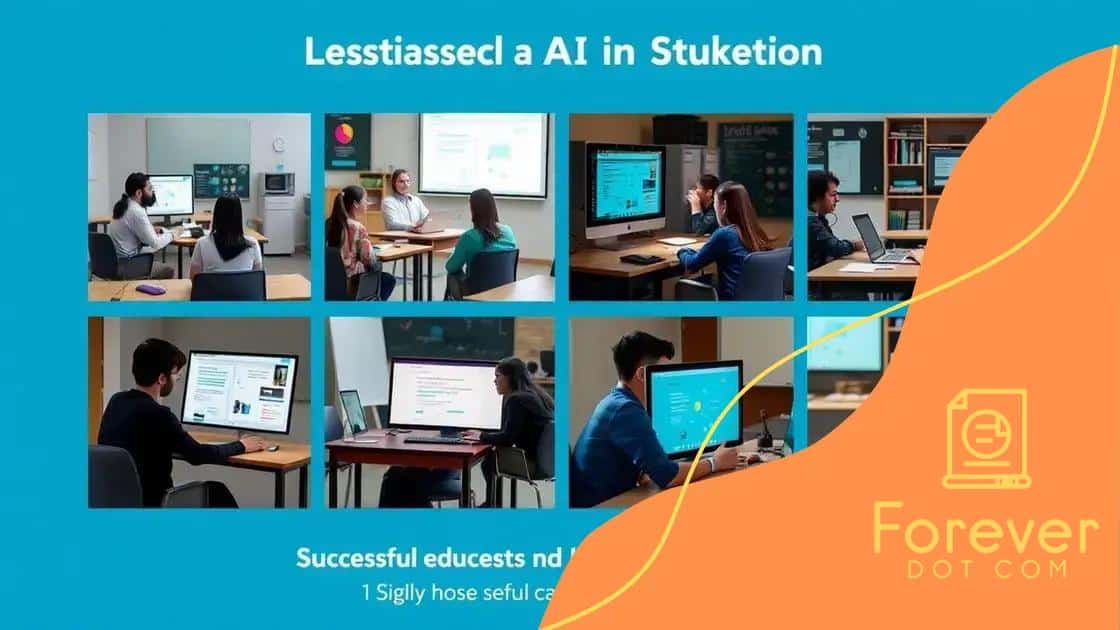The role of artificial intelligence in education accessibility

The role of artificial intelligence in education accessibility focuses on enhancing learning experiences through personalized tools, adaptive systems, and improved resources for diverse learners, ensuring equitable opportunities for all students.
The role of artificial intelligence in education accessibility is a crucial topic that shapes the future of learning. How can AI make education more accessible for everyone? Let’s dive in and explore the possibilities.
Understanding the impact of AI on learning environments
Understanding the impact of artificial intelligence on learning environments is essential as we move toward a more integrated educational experience. AI is helping educators tailor learning to meet diverse needs, ensuring that every student has access to quality education.
Personalized Learning Experiences
One of the biggest advantages of AI in education is its ability to create personalized learning experiences. These systems analyze student performance and adapt curricula to fit individual learning styles.
- Adjusts difficulty based on student performance.
- Provides resources tailored to student interests.
- Tracks progress over time for better outcomes.
This personalization encourages students to engage more deeply with their studies. When learning aligns with their preferences and strengths, students often perform better.
Enhancing Accessibility
AI technologies also enhance accessibility in education. Students with disabilities can benefit from tools that improve interaction with learning materials. Tools such as speech recognition and text-to-speech software break down barriers, allowing all students to participate fully.
Additionally, AI can help educators identify students who may need extra support. By analyzing data, teachers can intervene early with students who might be struggling, ensuring timely assistance and better learning outcomes. This proactive approach fosters a more inclusive educational environment.
Artificial intelligence is not just a trend; it’s transforming learning environments for the better. By embracing these technologies, educators can create dynamic classes that cater to everyone’s needs. As AI continues to develop, the potential for enriching education only expands. Staying informed about these advancements is key to harnessing their full benefits.
AI tools that enhance accessibility for all students
AI tools that enhance accessibility for all students are changing the landscape of education. These technologies support learners of different backgrounds and abilities, making learning more inclusive.
Speech Recognition Software
One essential AI tool is speech recognition software. This technology enables students with disabilities to interact with learning materials using their voice. This is particularly helpful for students who may struggle with traditional writing methods.
- Allows hands-free interaction with educational content.
- Improves engagement for students with motor disabilities.
- Can assist language learners in pronunciation.
By simplifying written communication, this technology empowers students to express their thoughts clearly, leveling the playing field in education.
Text-to-Speech Applications
An additional AI application is text-to-speech technology. This tool reads aloud written content, helping students with visual impairments or reading difficulties access the same materials as their peers.
With text-to-speech, students can listen to textbooks, articles, and assignments. This not only aids comprehension but also allows them to absorb information at their own pace.
AI can also provide customized learning experiences. For example, it can analyze a student’s learning patterns and adjust resources in real time. This means that students receive support tailored to their unique needs.
Interactive Learning Platforms
Interactive platforms use AI to create enriched learning experiences. These tools present information in various formats, adapting to different learning styles.
- Visual, auditory, and kinesthetic learning options.
- Engaging simulations and real-life scenarios.
- Immediate feedback on quizzes and activities.
This versatility ensures that every student, regardless of their learning preferences, can thrive. With AI tools, educators can create classrooms that are not only more interactive but also more accessible to everyone.
Case studies: AI success stories in education

Case studies of AI success stories in education showcase the transformative power of technology. Many schools and institutions have implemented AI solutions that significantly improve student outcomes.
Personalized Tutoring Systems
One notable example is a personalized tutoring system used in various districts. This AI-driven platform adapts to each student’s learning pace and style, offering tailored lessons and exercises. As a result, students often show remarkable improvements in their grades and self-confidence.
- Data-driven insights help identify areas for improvement.
- Tutoring sessions are tailored based on individual needs.
- Fosters independent learning and responsibility.
This approach helps students take control of their learning journeys, making education more effective.
AI for Special Needs Education
Another success story comes from schools that have integrated AI for special needs education. AI tools assist teachers in creating custom learning materials for students with disabilities. These tools analyze performance data and suggest adjustments to lesson plans.
For instance, a school implemented a program that used AI to enhance communication for non-verbal students. By doing so, students connected more with their peers, leading to improved social interactions.
Data Analytics to Inform Teaching
Moreover, many educational institutions are leveraging AI for data analytics. These systems analyze vast amounts of student data, helping educators make informed decisions.
- Identifies trends in student performance.
- Allows for early intervention with struggling students.
- Enhances curriculum development based on real data.
This data-driven approach is changing how teachers plan their lessons, ensuring that their methods align with students’ needs.
These examples demonstrate that integrating AI in education can lead to innovative solutions and better outcomes for students. By focusing on personalized and inclusive strategies, schools can create environments where every student has the opportunity to succeed.
Challenges in implementing AI for education
Challenges in implementing AI for education can often hinder the progress that schools are striving to achieve. While the benefits of AI are clear, the path to successful integration is not without obstacles.
Cost of Implementation
One significant challenge is the cost associated with adopting AI technologies. Many schools face budget constraints that make it difficult to invest in the necessary tools and training.
- Licensing fees for AI software can be high.
- Training teachers to use new systems requires time and funds.
- Maintaining and updating technology involves ongoing costs.
As a result, schools might have to prioritize spending, potentially sidelining important AI initiatives.
Data Privacy Concerns
Another major issue involves data privacy. Schools must ensure that the data collected by AI systems is protected, safeguarding students’ information from breaches.
These concerns often lead to hesitation among administrators to fully implement AI solutions.
Resistance to Change
Resistance to change from educators and stakeholders can also impede the integration of AI. Some teachers may feel overwhelmed by the technology or skeptical about its effectiveness.
- Training and support are crucial for easing this transition.
- Open discussions about benefits can help alleviate fears.
- Involving teachers in the decision-making process fosters buy-in.
Creating an environment that encourages acceptance of AI tools can take time and effort, yet it is essential for success.
Technical Limitations
Technical limitations present another challenge. Not all schools have the infrastructure needed to support advanced AI systems, especially in underfunded districts. This lack of resources can significantly hinder the implementation process, leaving some students and schools behind.
Despite these challenges, overcoming them is possible with careful planning and collaboration. Schools must assess their needs and find solutions that fit within their capabilities.
Future trends in AI and education accessibility
Future trends in AI and education accessibility are poised to revolutionize how students learn and interact with technology. As advancements continue, new tools will emerge to further enhance accessibility in learning environments.
Adaptive Learning Systems
One significant trend is the development of adaptive learning systems. These systems use AI to personalize education for individual students. By analyzing performance data, they provide customized resources that cater to specific needs, ensuring that all students receive the support they require.
- Adjusting content difficulty to match student abilities.
- Creating personalized learning paths.
- Offering targeted feedback to improve understanding.
This tailored approach promotes a more engaging experience, allowing students to learn at their own pace.
Enhanced Accessibility Features
Another trend includes improved accessibility features in educational apps and platforms. AI is being integrated in ways that help students with disabilities navigate learning materials more easily.
For example, platforms are now offering real-time captioning and translation services, making it easier for non-native speakers and hearing-impaired students to participate in classrooms. This level of inclusivity is essential for creating equitable learning opportunities.
AI-Driven Analytics
AI-driven analytics will also play a crucial role in the future of education. By collecting and analyzing data on student behavior and performance, educators can make informed decisions about curriculum and teaching methods.
- Identifying trends in student engagement.
- Tracking progress in real-time.
- Using insights to adapt teaching strategies.
This data-informed approach can lead to more effective instruction and happier learners. As AI becomes more sophisticated, its application in education will only continue to grow.
As these future trends emerge, the potential for enhancing accessibility in education is vast. Staying updated on technological advancements will empower educators to create more inclusive classrooms that cater to every student’s needs.
FAQ – Frequently Asked Questions about Artificial Intelligence in Education Accessibility
How does AI improve accessibility in education?
AI enhances accessibility by customizing learning experiences, providing tools like speech recognition, and offering real-time support for students with disabilities.
What are some examples of AI tools used in classrooms?
Examples include personalized tutoring systems, text-to-speech applications, and interactive learning platforms that engage students effectively.
What challenges do schools face when implementing AI?
Challenges include costs, data privacy concerns, resistance to change among educators, and the lack of technical infrastructure.
What future trends can we expect in AI and education?
Future trends include adaptive learning systems, enhanced accessibility features, and AI-driven analytics to inform teaching practices.






